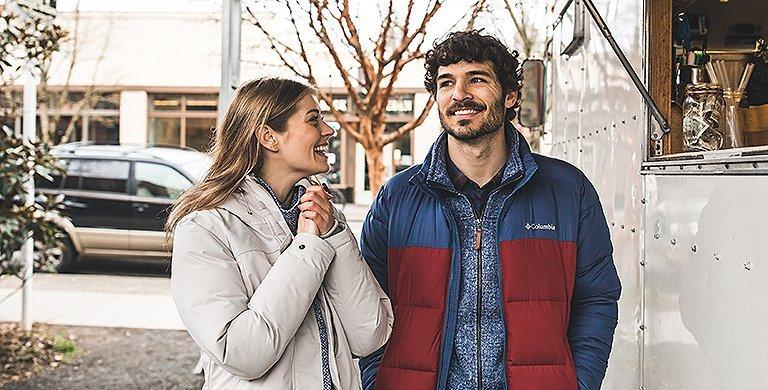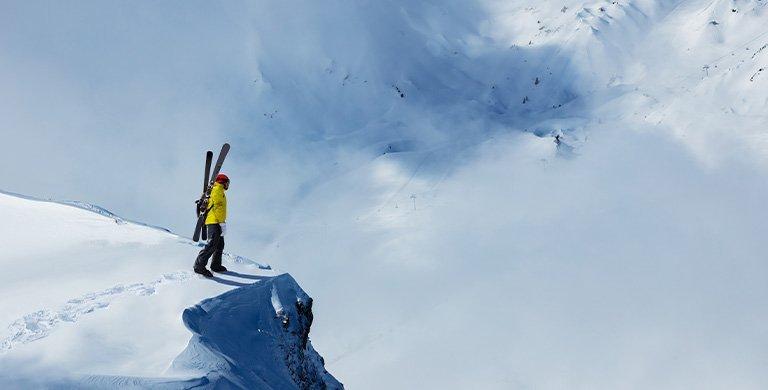Photo Credit: Corey Woosley
OUTDOOR LIFE
Kitchenless Cooking: An Adventure Chef Shares Her Top Secrets for Making Amazing Campfire Meals
Camping season may be several months away, but wilderness chef Sophie Hollingsworth is already talking about ways to improve your outdoor culinary game this spring
BY RACHEL CAVANAUGH
Sophie Hollingsworth likes to refer to her culinary style as what would happen if “Indiana Jones and Martha Stewart threw a dinner party.”
The wilderness explorer, whose adventures have included trekking through the Namibian desert and descending uncharted rivers in Madagascar, is well versed in backcountry cooking. Aside from her own personal experiences, she runs A Taste of Adventure, an adventure catering business that creates immersive wilderness cooking experiences.
She says that people are naturally drawn to cooking over open fires, as it’s something we’ve been doing for thousands of years.
“Ingredients and methods change, but cooking over the fire is (rooted) deep in our ancestral DNA,” she explains. “I reckon the love of the fire is innate in all humans—even if it is buried deep down.”
According to Sophie, it’s not as daunting as it may seem to make rich and savory meals when you’re out in the wilderness.
“It doesn’t matter if you’re a first-time fire cook or a seasoned pit master, as long as you have access to firewood, a knife, and some basic ingredients, you can have delicious fire-cooked feasts on your adventures or in your backyard.”
To help you take your camping meals, or post-hike picnic, to the next level, we asked Sophie to share her top camp-cooking tips. Check them out below to learn how to make your food taste better and more mouthwatering when you’re grilling in the great outdoors.
The wilderness explorer, whose adventures have included trekking through the Namibian desert and descending uncharted rivers in Madagascar, is well versed in backcountry cooking. Aside from her own personal experiences, she runs A Taste of Adventure, an adventure catering business that creates immersive wilderness cooking experiences.
She says that people are naturally drawn to cooking over open fires, as it’s something we’ve been doing for thousands of years.
“Ingredients and methods change, but cooking over the fire is (rooted) deep in our ancestral DNA,” she explains. “I reckon the love of the fire is innate in all humans—even if it is buried deep down.”
According to Sophie, it’s not as daunting as it may seem to make rich and savory meals when you’re out in the wilderness.
“It doesn’t matter if you’re a first-time fire cook or a seasoned pit master, as long as you have access to firewood, a knife, and some basic ingredients, you can have delicious fire-cooked feasts on your adventures or in your backyard.”
To help you take your camping meals, or post-hike picnic, to the next level, we asked Sophie to share her top camp-cooking tips. Check them out below to learn how to make your food taste better and more mouthwatering when you’re grilling in the great outdoors.
Adventure chef Sophie Hollingsworth says that one of the keys to successful wilderness cooking is bringing the right tools. Among other gear, she often uses a braai grill plate (pictured left) which fits over the spare tire of a vehicle and converts any open flame into an instant grill. Photo Credits: (Left) Corey Woosley; (Right) Rich Vidin
How to make camping food taste better
#1: Avoid direct flames
At the beginning of many people’s fire-cooking journey, they try cooking food on direct flame, Sophie explains. Avoid it and instead make use of glowing coals.
#2: Be selective with your wood
Quality wood will affect the flavor of the food you are cooking, so you should always try to use good wood, she says. Hardwoods such as oak, ash, and beech are best for steady heat, as they burn for a long time. Softwoods such as pine will burn faster and hotter, which is not ideal. If you are using any chemicals or firelighters, it’s important to keep it as natural as possible to ensure a clean flavor (and no harmful impact on the planet).
#3: Bring the right tools
Often when we first set out fire cooking, we think about all of the big things—the wood, the matches, and the ingredients—but we forget the smaller things like the fireproof gloves, hot sauce, and tongs, Sophie says. While often the small things are not essential, they do help make the whole experience a bit more enjoyable. I also take a braai grill plate with me wherever I go. It fits on the spare tire of my four-wheel drive vehicle and makes converting a fire pit into a grill a super easy process.
At the beginning of many people’s fire-cooking journey, they try cooking food on direct flame, Sophie explains. Avoid it and instead make use of glowing coals.
#2: Be selective with your wood
Quality wood will affect the flavor of the food you are cooking, so you should always try to use good wood, she says. Hardwoods such as oak, ash, and beech are best for steady heat, as they burn for a long time. Softwoods such as pine will burn faster and hotter, which is not ideal. If you are using any chemicals or firelighters, it’s important to keep it as natural as possible to ensure a clean flavor (and no harmful impact on the planet).
#3: Bring the right tools
Often when we first set out fire cooking, we think about all of the big things—the wood, the matches, and the ingredients—but we forget the smaller things like the fireproof gloves, hot sauce, and tongs, Sophie says. While often the small things are not essential, they do help make the whole experience a bit more enjoyable. I also take a braai grill plate with me wherever I go. It fits on the spare tire of my four-wheel drive vehicle and makes converting a fire pit into a grill a super easy process.
“Cooking over the fire is all about slowing down to enjoy the outdoors.” ~Sophie Hollingsworth
#4. Practice resourcefulness
You won't have access to all of the kitchen tools you are used to, she explains. Being outdoors and in nature is about simplifying—the less you have, the more creative you need to be, she says. When I first got into fire cooking, the creative ways I was cooking came out of necessity over artistic flare. For instance, my seafood-on-a-stick recipe evolved from the fact that out camping in Western Australia, I came across a fish that was way too big for any of my cast-iron pans, so I thought I could truss the fish to a stick to cook it over the fire. It worked and became my favorite way to cook fish over the fire, even if I have access to the right pans.
#5. Be patient
When cooking over a fire, nothing is as instantaneous nor do you have all the tools or options that most people are accustomed to in the kitchen, Sophie says. Everything takes longer. In our age of instant gratification, we’ve become used to microwaves heating up food and gas stoves providing fire all within a matter of seconds. With a fire, that is simply not the case. Patience is probably the most important element of cooking over the fire. Cooking over the fire is all about slowing down to enjoy the outdoors—and it’s even better with company. At first you will inevitably undercook, overcook, and drop things in the fire. That’s life. Enjoy the time in the outdoors and be patient with the fire-cooking journey.
#6. Don’t forget safety
Make sure it is safe to have a fire and you are prepared should the flames get out of hand, Sophie says. Lighting the neighborhood or national park on fire would certainly put a damper on the cookout.
If you’re excited about improving your outdoor culinary skills for your next adventure, check out some of Sophie’s favorite camping recipes below.
You won't have access to all of the kitchen tools you are used to, she explains. Being outdoors and in nature is about simplifying—the less you have, the more creative you need to be, she says. When I first got into fire cooking, the creative ways I was cooking came out of necessity over artistic flare. For instance, my seafood-on-a-stick recipe evolved from the fact that out camping in Western Australia, I came across a fish that was way too big for any of my cast-iron pans, so I thought I could truss the fish to a stick to cook it over the fire. It worked and became my favorite way to cook fish over the fire, even if I have access to the right pans.
#5. Be patient
When cooking over a fire, nothing is as instantaneous nor do you have all the tools or options that most people are accustomed to in the kitchen, Sophie says. Everything takes longer. In our age of instant gratification, we’ve become used to microwaves heating up food and gas stoves providing fire all within a matter of seconds. With a fire, that is simply not the case. Patience is probably the most important element of cooking over the fire. Cooking over the fire is all about slowing down to enjoy the outdoors—and it’s even better with company. At first you will inevitably undercook, overcook, and drop things in the fire. That’s life. Enjoy the time in the outdoors and be patient with the fire-cooking journey.
#6. Don’t forget safety
Make sure it is safe to have a fire and you are prepared should the flames get out of hand, Sophie says. Lighting the neighborhood or national park on fire would certainly put a damper on the cookout.
If you’re excited about improving your outdoor culinary skills for your next adventure, check out some of Sophie’s favorite camping recipes below.
Photo Credits: Sophie Hollingsworth
Sophie’s Campfire Recipes
Fire-Smoked Bacon
INGREDIENTS
Bacon
TOOLS
2 Y-shaped sticks
1 straight stick
INSTRUCTIONS
1.) Light a fire and let it burn down to a medium heat.
2.) Find two Y-shaped sticks. Dig two small holes on either side of the campfire, far enough from the flames so as not to ignite. If necessary, use rocks to ensure the Y sticks can stand on their own.
3.) Find one straight stick. Make sure it is strong enough to hold the bacon but thin enough to allow the meat to cook. Carefully place your straight stick perpendicular across the two Y sticks.
4.) Delicately hang the bacon over the straight stick, flipping it occasionally. Depending on your crispy preference index and your fire level, bacon can take anywhere from 20 minutes to one hour.
INGREDIENTS
TOOLS
INSTRUCTIONS
1.) Light a fire and let it burn down to a medium heat.
2.) Find two Y-shaped sticks. Dig two small holes on either side of the campfire, far enough from the flames so as not to ignite. If necessary, use rocks to ensure the Y sticks can stand on their own.
3.) Find one straight stick. Make sure it is strong enough to hold the bacon but thin enough to allow the meat to cook. Carefully place your straight stick perpendicular across the two Y sticks.
4.) Delicately hang the bacon over the straight stick, flipping it occasionally. Depending on your crispy preference index and your fire level, bacon can take anywhere from 20 minutes to one hour.
Photo Credit: Alan McNaughton
Fish Sticks
INGREDIENTS
1 whole fish (scaled and gutted)
1 lemon
1 small onion
Citrus leaves or other local herbs
Salt and pepper
TOOLS
1 straight stick (preferably oak wood or citrus, if possible
Cooking twine
Small hand shovel
INSTRUCTIONS
1.) Light a fire and let it burn down to a medium heat.
2.) Thinly cut 2 to 3 slices of lemon and 2 to 3 slices of onion.
3.) Stuff the lemon and onion slices into the cavity of the fish, along with the herbs or citrus leaves, and top with a pinch of salt and pepper.
4.) Run the straight stick up the cavity and out the mouth of the fish. Use the cooking twine to secure the fish to the stick and also to prevent the lemons, onions, and herbs from falling out.
5.) If you have more fish, repeat for each fish.
6.) Use the shovel to dig a series of holes in the ground, approximately 6 inches to 1 foot from the fire. Insert each stick into a hole. For added stability, build sand or dirt mounds around each stick.
7.) Cook fish for approximately 10 minutes per side. Cooking times can vary. The fish is done when you can peel back the crispy skin to reveal tender meat about to fall off the bone.
8.) Serve hot with lemon wedges.
INGREDIENTS
TOOLS
INSTRUCTIONS
1.) Light a fire and let it burn down to a medium heat.
2.) Thinly cut 2 to 3 slices of lemon and 2 to 3 slices of onion.
3.) Stuff the lemon and onion slices into the cavity of the fish, along with the herbs or citrus leaves, and top with a pinch of salt and pepper.
4.) Run the straight stick up the cavity and out the mouth of the fish. Use the cooking twine to secure the fish to the stick and also to prevent the lemons, onions, and herbs from falling out.
5.) If you have more fish, repeat for each fish.
6.) Use the shovel to dig a series of holes in the ground, approximately 6 inches to 1 foot from the fire. Insert each stick into a hole. For added stability, build sand or dirt mounds around each stick.
7.) Cook fish for approximately 10 minutes per side. Cooking times can vary. The fish is done when you can peel back the crispy skin to reveal tender meat about to fall off the bone.
8.) Serve hot with lemon wedges.
Photo Credit: Corey Woosley
Smoked Pineapple Dessert Recipe
INGREDIENTS1 to 2 very ripe pineapples
1 to 2 bottles of sweet wine
3 cups of sugar
TOOLSBall of cooking twine
Medium saucepan
Cast-iron stick, tripod, or other hanging apparatus
INSTRUCTIONS
1.) Light a fire and let it burn down to a medium heat.
2.) While the fire is settling, cut the skin off each pineapple, making sure to keep the crown intact.
3.) Wrap the cooking twine around the base of each pineapple crown so it can be hung over the fire.
4.) Mix the wine and sugar in a medium saucepan and set over the fire at medium-high heat, stirring occasionally so the sugar dissolves into a syrup.
5.) Dip each pineapple into the syrup and hang over the fire using the cooking twine and cast-iron rod.
6.) Every half hour for at least 3 hours, dip each pineapple back into the syrup and continue cooking, turning occasionally to evenly brown the exterior.
7.) Slice and serve. Eat by itself or pair with your choice of desserts (vanilla ice cream, brownies, cheese, pavlova, etc.)
INGREDIENTS
TOOLS
INSTRUCTIONS
1.) Light a fire and let it burn down to a medium heat.
2.) While the fire is settling, cut the skin off each pineapple, making sure to keep the crown intact.
3.) Wrap the cooking twine around the base of each pineapple crown so it can be hung over the fire.
4.) Mix the wine and sugar in a medium saucepan and set over the fire at medium-high heat, stirring occasionally so the sugar dissolves into a syrup.
5.) Dip each pineapple into the syrup and hang over the fire using the cooking twine and cast-iron rod.
6.) Every half hour for at least 3 hours, dip each pineapple back into the syrup and continue cooking, turning occasionally to evenly brown the exterior.
7.) Slice and serve. Eat by itself or pair with your choice of desserts (vanilla ice cream, brownies, cheese, pavlova, etc.)
Need warm clothes for your outdoor cooking adventures? Check out Columbia Sportswear’s selection.
We can’t supply firewood, but we sure can keep you warm.
We can’t supply firewood, but we sure can keep you warm.



